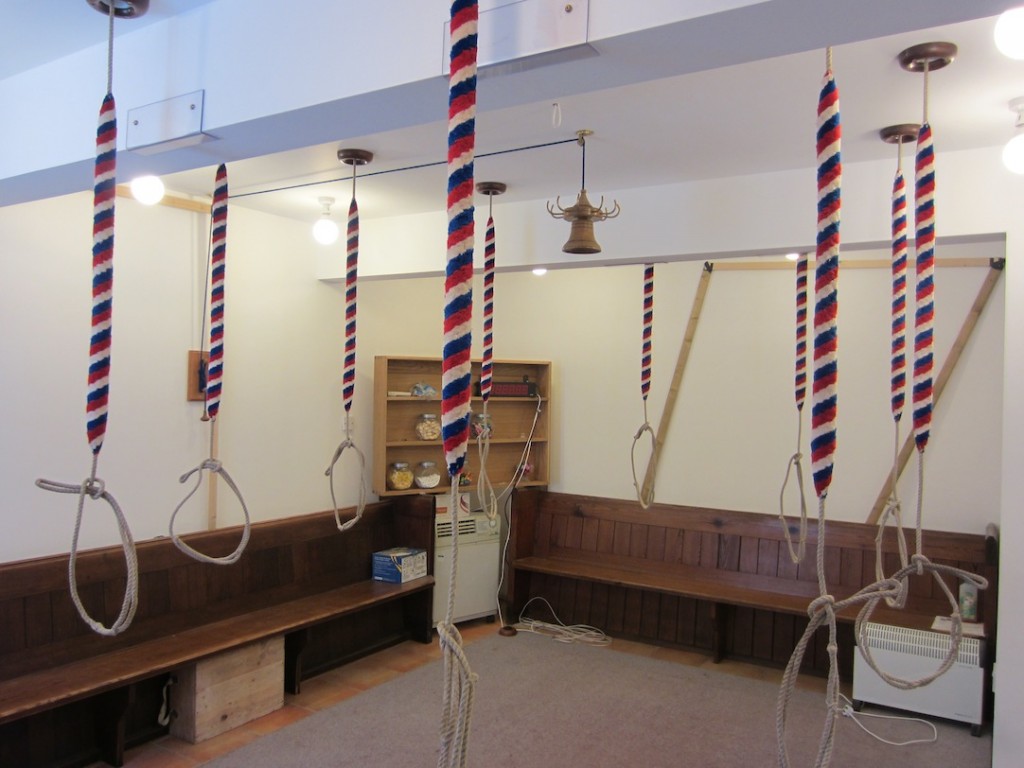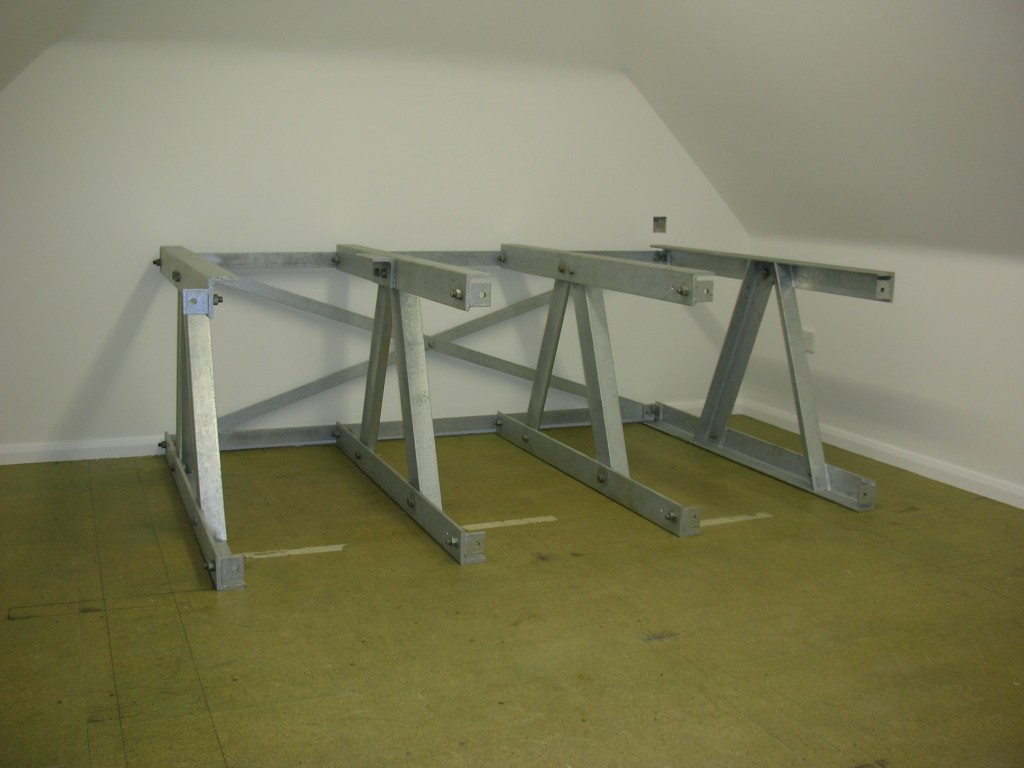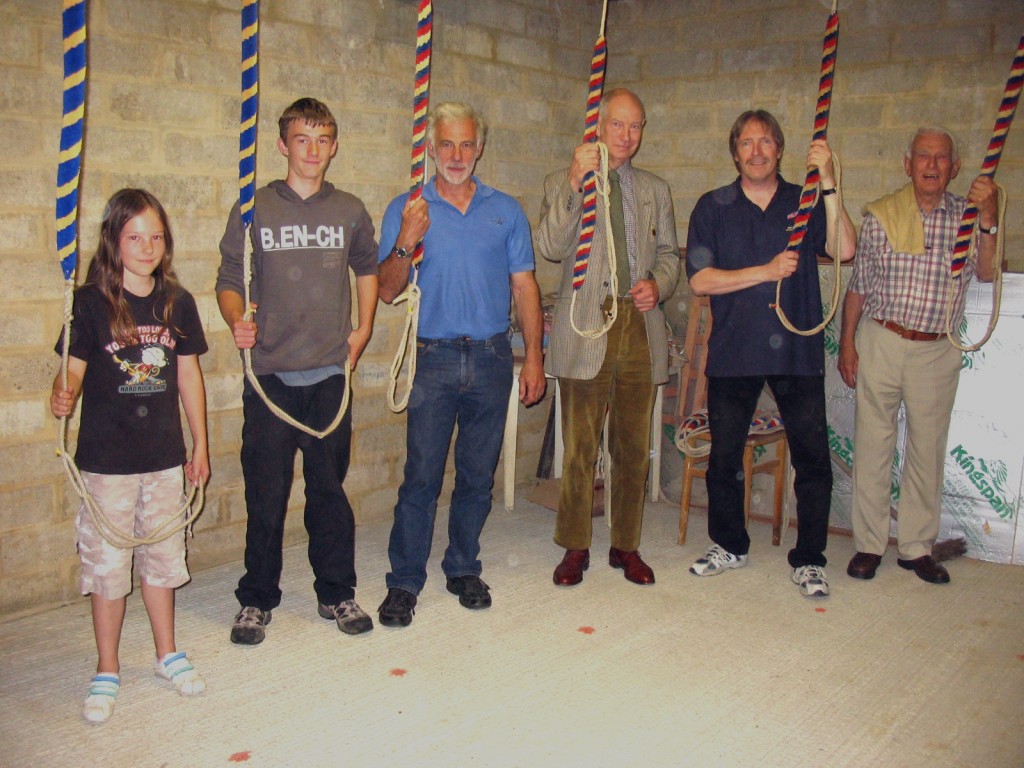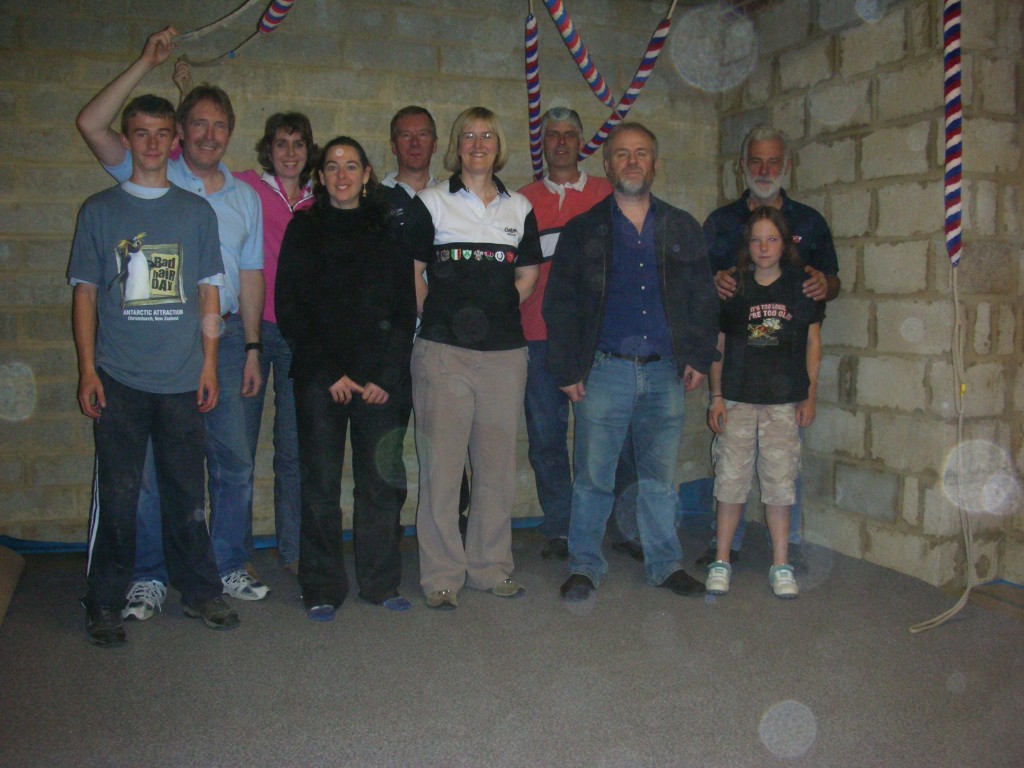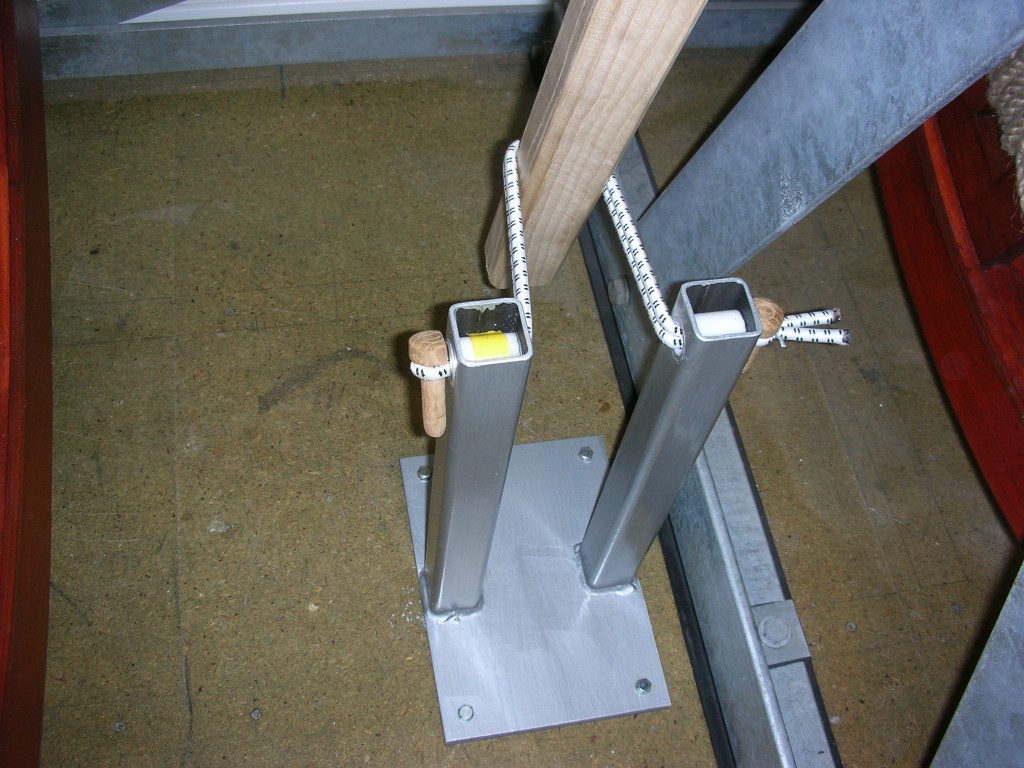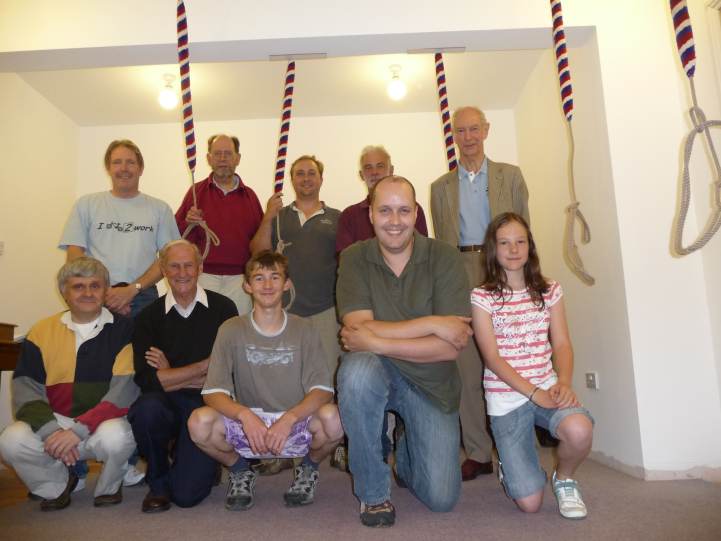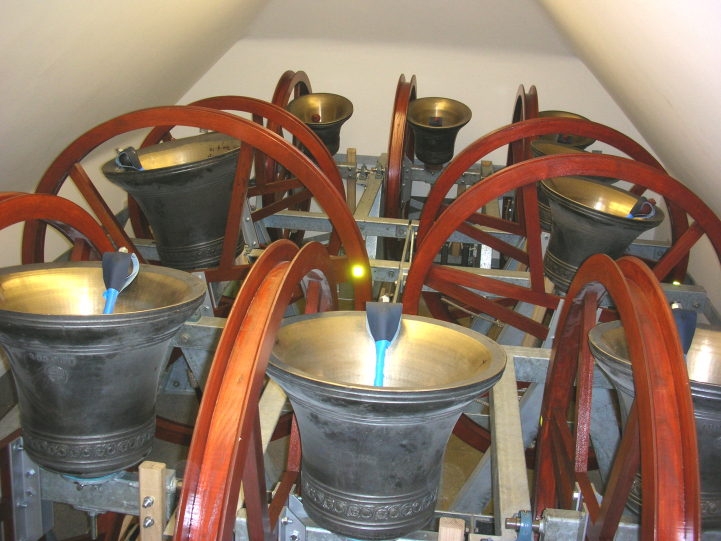Bell details
BELL WEIGHT DI NOTE
1: 0-3-16 14.13” G♯
2: 0-3-25 15.00” F♯
3: 0-3-24 15.63” E
4: 1-0-05 15.88” D♯
5: 1-0-22 17.00” C♯
6: 1-1-02 17.88” B
7: 1-1-21 18.88” A
8: 1-2-04 19.50” G♯
9: 1-3-22 21.38” F♯
10: 3-1-02 25.13” E
The Story of the Bells
Many different ringing ideas have started out as pub discussions. “Clock House Bells” is not one of them. Back in the early 1980s I took John Dodd for a ring on Martin and Steve Hough’s miniring in Liss. It was a cold February morning and he was just recovering from a bad bout of flu. “They’re buckets”, I told him. He thought I meant they were not very good. I meant they were buckets! From that traumatic experience John decided he would like his own ring of bells but something that looked and sounded like a “real” ring of bells.
Move forward to the mid 90s. Minirings were starting to spring up everywhere and John decided it was time to seriously start investigating the possibility of having his own “proper” ring of bells. We visited Eijsbouts and discussed casting and hanging a 1 cwt ring of ten. Eijsbouts could cast the bells but had little idea about the hanging and clappering so John decided it would be prudent to go to an English bell foundry.
With a 1 cwt ring in mind, John designed a ringing room as part of his new garage complex. His original idea was to get all the bells cast as close as possible to the same size and weight to make construction of wheels and other parts as simple as possible. He was talked out of this idea by Andrew Craddock and was persuaded by the late Gordon Halls to go for something a little heavier with a properly graduated weight scale and a much more substantial “tower” to accommodate them.
Plans for an extension to the garage complex, known officially as the “outdoor utility room”, were submitted and passed. The buildings inspector was most amused by the over-engineered design. He couldn’t understand why John wanted foundations capable of supporting, as he put it, “a 14 storey block of flats”.
The plans were then put on hold for over 4 years while other things took priority but in 2005 the building of the tower restarted and the shell was completed the same year. From the outside it appears as a brick building but its strength comes from the core construction of concrete blocks laid flat and the top 3 courses reinforced with stainless steel.
In 2006, with tremendous help from R & J Engineering of Chandlers Ford, the frame and headstocks were completed. In 2007 the frame was installed and the treble and tenor hung.
In 2008 the pulley boxes and wheels, all constructed by John himself, were completed, fitted and installed. During this time, as soon as the front 6 were ready, they were the subject of the tryout and first quarter peal – Plain Bob Doubles on 15th August 2008.
Shortly after this all ten bells were installed. Although stays and sliders had not yet made an appearance, several quarters were rung on 6, 8 and 10 bells over the next few weeks and it soon became clear that the clappering was not right. The sound levels were very unbalanced and several bells suffered from double clappering. Months of experimenting and “tweaking” with occasional quarter peals followed but to no avail. Then, enter Matthew Higby.
With his experience over many years of making little bells ring and clapper like big bells, Matthew produced a new set of clappers which immediately cured most of the sound problems. After a quarter of Cambridge S Royal in June 2009, when several of the ringers used earplugs, only volume needed to be addressed. This was done by fitting thin layers of leather around the clappers. At the same time John answered another question that had been under discussion for some time – to set the bells or not to set the bells.
Minirings don’t have stays and sliders. They would make the bells too hard to ring. Also, some ringers have problems with small bells because they are set too finely. Broken stays are a feature of these places. Not wanting to discourage visitors but not wanting to be forever replacing broken stays, John came up with a novel and possibly unique setting mechanism. The stay is traditional. The slider is replaced with 2 x 40mm box sections welded to a steel plate then positioned either side of the stay and bolted to the floor. A simple bungee cord is fixed between the 2 box sections. The stay engages with this and comes to rest gradually with no chance of banging the stay too hard. As a bonus, this mechanism is also completely silent.
With everything now working properly and the bells a pleasure to ring, the first peal was attempted and scored on Friday 24th July. John’s daughter Harriet rang the treble to what was only her second peal, a year after her first and rather more traumatic attempt. It’s quite amazing how much difference a year makes when you are still a long way from being a teenager.
WINCHESTER & PORTSMOUTH DIOCESAN GUILD
AWBRIDGE, Hants, Clock House Bells
Fri Jul 24 2009 2:37 (2)
5021 Grandsire Caters
Comp. arr R LeMarechal from A M Tyler
1 Harriet J Dodd
2 Matthew R T Higby
3 Andrew J Dodd
4 Brian J Woodruffe
5 John P Colliss
6 Roy LeMarechal (C)
7 Barry J Fry
8 Graham J Wright
9 John A Dodd
10 Martin K Waldron
First Peal on the bells.
There are still some jobs to do to make them a really first class ring of bells and John, never one to rest, is working on them. But, right now, everything is working properly and the tower is available (by arrangement) to visitors for outings, etc. John is also very happy to talk to anybody who might have similar ideas for “garage extensions”.
Written by R LeMarechal for the Ringing World



